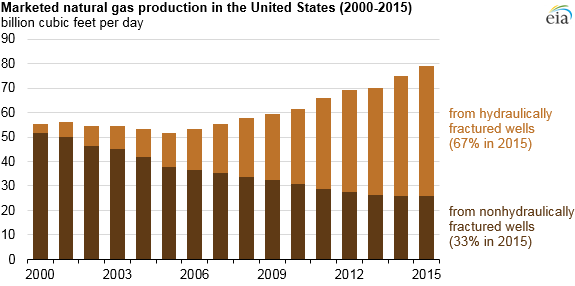May 2016, Vol. 243, No. 5
Web Exclusive
Fracking Wells Provide Two-Thirds of US Natural Gas Production

For decades, hydraulic fracturing had been referred to as an unconventional completion technique, but over the past 10 years it has become the technique by which most natural gas is produced in the United States. Based on the most recent data from states, EIA estimates that natural gas production from hydraulically fractured wells now makes up about two-thirds of total U.S. marketed gas production. This share of production is even greater than the share of crude oil produced using that method, where hydraulic fracturing accounts for about half of current U.S. crude oil production.
Hydraulic fracturing, often in combination with horizontal drilling, involves forcing a liquid (primarily water) under high pressure from a wellbore against a rock formation until it fractures. The fracture lengthens as the high-pressure liquid in the wellbore flows into the formation. This injected liquid contains a proppant, or small, solid particles (usually sand or a manmade granular solid of similar size), that fills the expanding fracture. When the injection is stopped and the pressure is reduced, the formation attempts to settle back into its original configuration, but the proppant keeps the fractures open. This allows hydrocarbons to flow from the rock formation back to the wellbore and then to the surface.
EIA created a profile of marketed natural gas production using well completion and production data from IHS Global Insight and DrillingInfo Inc. that shows a dramatic increase in production associated with hydraulic fracking. In 2000, approximately 26,000 hydraulically fractured wells produced 3.6 billion cubic per day (Bcf/d) of marketed gas in the United States, making up less than 7% of the national total. By 2015, the number of hydraulically fractured wells had grown to an estimated 300,000, and production from those wells had grown to more than 53 Bcf/d, making up about 67% of the total natural gas output of the United States. These results may vary from other sources because of the types of wells included in the analysis, update schedules of source databases, and the specific types of natural gas volumes analyzed.
EIA measures natural gas production in three ways. Gross withdrawals are the full volume of compounds extracted at the wellhead, which includes all natural gas liquids and nonhydrocarbon gases after the oil, lease condensate, and water have been removed. Marketed natural gas production excludes natural gas used for repressuring the well, vented and flared gas, and any nonhydrocarbon gases. Marketed gas is further processed into dry natural gas, also known as consumer-grade natural gas. This process involves not only extracting valuable hydrocarbon gas liquids such as ethane and propane, but also removing impurities such as water vapor and noncombustible gases that would interfere with pipeline operations or end-use applications.
Natural gas production from hydraulic fracturing has primarily come from shale and other tight rocks in the Marcellus and Utica formations of the Appalachian Basin, the Bakken formation in Montana and North Dakota, the Eagle Ford formation in Texas, and the stacked Permian Basin formations in Texas and New Mexico. Monthly natural gas production by geologic formation can be found at EIA’s Natural Gas Weekly Update. Production and other drilling metrics by geographic area can be found in EIA’s Drilling Productivity Report.

Hydraulic fracturing is not limited to natural gas-containing formations such as shales or other source rocks, nor is it limited to horizontal wells. Hydraulic fracturing has been successfully used in directional and vertical wells, natural gas and oil wells, and in non-tight formations and reservoirs. To date, most natural gas from hydraulically fractured wells has come from Lower 48, onshore tight rock formations.





Comments